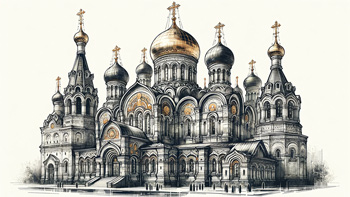The Eastern Orthodox Church, with its profound historical roots and rich traditions, represents a cornerstone of Christian faith, particularly in the Eastern part of the world. This branch of Christianity, distinct in its practices and beliefs, is exemplified through the magnificence and spiritual depth of Orthodox churches. These structures are not merely places for worship but also serve as emblems of cultural and historical heritage, mirroring the evolution of this unique religious path.
Historical Roots of the Eastern Orthodox Church
Tracing its origins back to the earliest Christian communities, the Eastern Orthodox Church has been a defining force in the religious and cultural landscapes of Eastern Europe and beyond. The historical journey of the Eastern Orthodox Church is intricately tied to the rise and fall of empires, the interplay of different cultures, and the enduring quest for religious expression. This rich history is vividly encapsulated in the architecture and artistry of Orthodox churches, which stand as testaments to the faith's resilience and adaptability.
Architectural Grandeur of Orthodox Churches
The distinct architectural style of Orthodox churches is a hallmark of the Eastern Orthodox Church. These structures are renowned for their domed silhouettes, intricate iconography, and ornate interiors. The design of Orthodox churches is not just an artistic endeavor but a symbolic representation of the church's theological principles. The harmonious blend of form and function in these buildings illustrates the Eastern Orthodox Church's approach to worship and its emphasis on creating a sacred space that elevates the spirit.
Iconography in the Eastern Orthodox Tradition
Iconography holds a place of particular reverence in the Eastern Orthodox Church. The creation and veneration of icons are central to Orthodox worship and spiritual practice. These religious images, rich in symbolism and meticulously crafted, are more than artistic creations; they are seen as spiritual windows, offering a glimpse into the divine. The tradition of iconography in Orthodox churches reflects the Eastern Orthodox Church's deep connection to its historical and theological roots.
The Role of Orthodox Churches in Community and Culture
In the realm of the Eastern Orthodox Church, Orthodox churches are more than just buildings; they are vibrant centers of community life. These churches serve as focal points for worship, celebration, and communal gatherings. They play a critical role in rites of passage, educational activities, and community support, thus weaving the Eastern Orthodox Church into the daily lives of its followers.
Diversity and Global Presence of Orthodox Churches
While united in faith and tradition, Orthodox churches exhibit a remarkable diversity reflective of the Eastern Orthodox Church's global presence. From the magnificent cathedrals in Russia to the historic churches in the Balkans and the Middle East, each region contributes its unique architectural and cultural nuances to the tapestry of the Eastern Orthodox Church. This diversity not only enriches the Eastern Orthodox tradition but also highlights its broad impact on global cultural heritage.
Contemporary Significance of the Eastern Orthodox Church
Today, the Eastern Orthodox Church continues to play a vital role both as a living religious community and as a guardian of historical heritage. Orthodox churches attract believers and non-believers alike, drawn by their spiritual aura and historical significance. In a rapidly changing world, these churches stand as enduring symbols of faith, tradition, and cultural continuity, bridging the past with the present and offering solace and inspiration.
The exploration of the Eastern Orthodox Church and its Orthodox churches is not merely an academic endeavor; it is a journey into the essence of a faith that has shaped the spiritual, cultural, and artistic landscapes of numerous societies. These churches, with their distinctive architectural features and rich traditions, continue to captivate and inspire, serving as living monuments to a deeply rooted and vibrant spiritual tradition.

